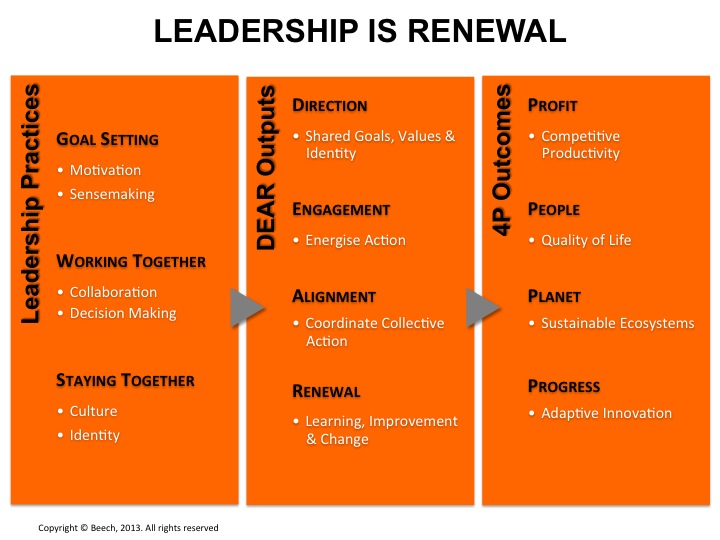Organizing for Performance and Renewal is an original framework created by Cambridge Leadership Development that enables sustainability and competitive renewal for businesses in the 21st century.
The CLD framework Organizing for Performance and Renewal is a practical tool for businesses in the 21st century. It includes:
- An emphasis on strategic purpose, processes, and people
- The addition of processes and engagement
Key Points:
- The importance of a stakeholder/constituency concept of enterprise performance, growth, and innovation in globally competitive markets
- Achieving a continuously evolving balance across the competing requirements of a quadruple bottom line of profits, people, planet, and progress in globally competitive markets.
In more detail a quadruple 4P bottom line addresses: i) profits – competitive productivity; ii) people – quality of life; iii) planet – ecosystems sustainability; and, iv) progress – adaptive innovation (continuous improvement and innovation; including business model innovation)
- A 21st century emphasis on purpose, processes, and people to complement and develop the 20th century emphasis on strategy, structure, and systems. This includes increased attention to the process routines that generate core capabilities in utilising and developing technologies.
- Increasing attention to engaging people to do willingly and well what needs to be done across cooperative and competitive networks within and beyond the enterprise.
- McKinsey found that ‘great companies create great meaning’. Establishing, sustaining, and renewing both common values and standards of behaviour and a sense of group membership and group identity are accepted as basic ingredients for enduring success.
- Acceptance that leadership is the decisive factor in promoting common values and group identity. More than this, the leadership role of managers is fundamental to engaging people and to coordinating people, resources, and activities for a common purpose in order to deliver mutual benefits for stakeholders.
Operational Implementation
Managers and their networks of colleagues, associates, and direct reports are responsible for achieving the strategic purpose of their part of an enterprise for the mutual benefit of stakeholders.
Some key questions to address are:
Strategic Purpose
- How well do you and everyone you work with understand the strategic purpose of your part of the enterprise?
- To what extent do you and everyone you work with see a link between your day to day activities and the strategic purpose of your part of the enterprise?
Context: PEST – political, economic, social, technological (+ legal, ecological, cross-cultural)
- How aware are you of the changing globally competitive context and the implications of these changes for you and your colleagues?
Resources
- What resources, assets, and technologies do you draw on to support you in achieving a high performance impact?
Processes
- What are the critical tasks, processes, and routines in your area of responsibility?
People
- Who is involved in your area of responsibility?
- What are their skills, motives, and values?
Structure
- How are activities and processes coordinated in your area of the enterprise?
- How is coordination between processes achieved across the network of relationships through which strategic purpose is progressed?
Systems
- What systems do you draw on to keep performance on track?
- What do you do to enable continuous improvements in performance?
Culture
- What are the links between common values and standards of behaviour and your leadership contribution?
Leadership
- What do you do to engage people in a common purpose for mutual benefit?
- How well do you establish structure?
- How well do you ensure mutual respect?
- What contribution do you make both to initiate change and to adapt to change?
- What do you do to involve people in decisions about the ends and means of action?
Engagement
- What do you do to mobilise and develop people so that they add value to enterprise performance?
Impact
- How well do you and everyone you work with understand the impact of your efforts on the relationships between employees, customers, financiers, and other stakeholders?
- What do you do to learn from the impact you have?
- If you had the authority what would you do to improve the coordination of people, resources, and activities so that the enterprise had more of an impact on stakeholders?
To discuss how this framework could be applied to your organization, please contact us.







